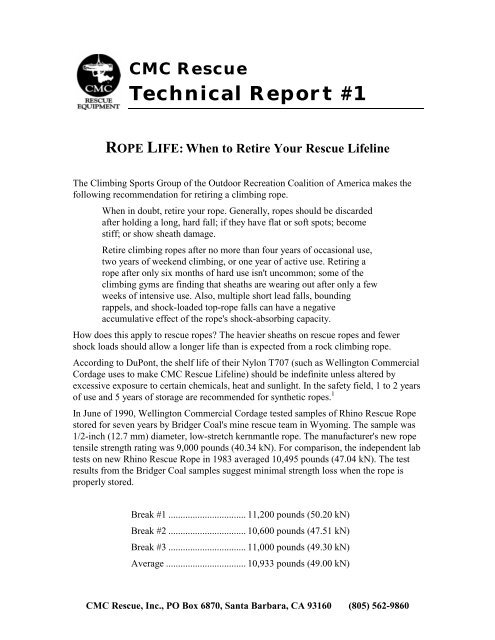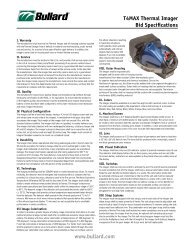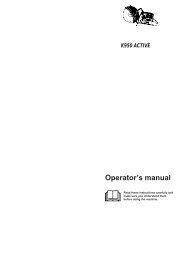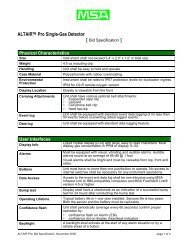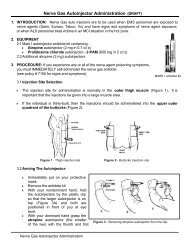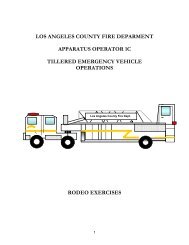Rope Life - New York Search & Rescue
Rope Life - New York Search & Rescue
Rope Life - New York Search & Rescue
Create successful ePaper yourself
Turn your PDF publications into a flip-book with our unique Google optimized e-Paper software.
CMC <strong>Rescue</strong><br />
Technical Report #1<br />
ROPE LIFE: When to Retire Your <strong>Rescue</strong> <strong>Life</strong>line<br />
The Climbing Sports Group of the Outdoor Recreation Coalition of America makes the<br />
following recommendation for retiring a climbing rope.<br />
When in doubt, retire your rope. Generally, ropes should be discarded<br />
after holding a long, hard fall; if they have flat or soft spots; become<br />
stiff; or show sheath damage.<br />
Retire climbing ropes after no more than four years of occasional use,<br />
two years of weekend climbing, or one year of active use. Retiring a<br />
rope after only six months of hard use isn't uncommon; some of the<br />
climbing gyms are finding that sheaths are wearing out after only a few<br />
weeks of intensive use. Also, multiple short lead falls, bounding<br />
rappels, and shock-loaded top-rope falls can have a negative<br />
accumulative effect of the rope's shock-absorbing capacity.<br />
How does this apply to rescue ropes? The heavier sheaths on rescue ropes and fewer<br />
shock loads should allow a longer life than is expected from a rock climbing rope.<br />
According to DuPont, the shelf life of their Nylon T707 (such as Wellington Commercial<br />
Cordage uses to make CMC <strong>Rescue</strong> <strong>Life</strong>line) should be indefinite unless altered by<br />
excessive exposure to certain chemicals, heat and sunlight. In the safety field, 1 to 2 years<br />
of use and 5 years of storage are recommended for synthetic ropes. 1<br />
In June of 1990, Wellington Commercial Cordage tested samples of Rhino <strong>Rescue</strong> <strong>Rope</strong><br />
stored for seven years by Bridger Coal's mine rescue team in Wyoming. The sample was<br />
1/2-inch (12.7 mm) diameter, low-stretch kernmantle rope. The manufacturer's new rope<br />
tensile strength rating was 9,000 pounds (40.34 kN). For comparison, the independent lab<br />
tests on new Rhino <strong>Rescue</strong> <strong>Rope</strong> in 1983 averaged 10,495 pounds (47.04 kN). The test<br />
results from the Bridger Coal samples suggest minimal strength loss when the rope is<br />
properly stored.<br />
Break #1 ................................ 11,200 pounds (50.20 kN)<br />
Break #2 ................................ 10,600 pounds (47.51 kN)<br />
Break #3 ................................ 11,000 pounds (49.30 kN)<br />
Average ................................. 10,933 pounds (49.00 kN)<br />
CMC <strong>Rescue</strong>, Inc., PO Box 6870, Santa Barbara, CA 93160 (805) 562-9860
Section 5.2.2 of ASTM F 1740 - 96 Guide for Inspection of Nylon, Polyester, or<br />
Nylon/Polyester Blend, or Both Kernmantle <strong>Rope</strong>, recommends ten years as a maximum<br />
rope life. How a rope is used and stored has a greater effect on rope life than any other<br />
factor.<br />
In June of 1992, National City (CA) Fire Department sent us a rope they described as old<br />
and well used. It was the worst looking of the ropes they had in service and its acquisition<br />
preceded any record keeping. The marker tape indicated the rope was BlueWater II<br />
manufactured in 1983. BlueWater's catalog specifies a 7,600 pound (34.06 kN) tensile<br />
strength for 1/2 inch (12.7 mm) diameter BlueWater II. Tested by Wellington<br />
Commercial Cordage, the results showed an approximate 15% strength loss after nearly<br />
10 years.<br />
Break #1 ................................ 6,400 pounds (28.69 kN)<br />
Break #2 ................................ 6,800 pounds (30.48 kN)<br />
Average ................................. 6,600 pounds (29.58 kN)<br />
Bruce Smith, co-author of On <strong>Rope</strong>, collected and broke over 100 samples of used caving<br />
rope. Using each rope's history, each sample was categorized as "like new", "used", or<br />
"abused". Like new ropes averaged a strength loss of 1.5 to 2 percent per year, and used<br />
ropes 3 to 4 percent per year. Smith observed that "care of the rope has a far greater<br />
impact on a rope's life than age." 2<br />
At this time the evidence suggests that with average use a rescue rope will lose 1.5 to 2<br />
percent of its strength per year. Under hard use, a rope can lose 3 to 5 percent per year.<br />
Once you decide the minimum strength for your lifeline, you can calculate the expected<br />
service life.<br />
Aside from shelf life and strength loss, the other reason for retirement is damage, or<br />
suspected damage. The inspection may find evidence of damage, or a team member may<br />
report that the rope suffered an impact load, was hit by a rock, or smashed between the<br />
stretcher and the wall. If you do decide to retire the rope, take it apart and look inside at<br />
the damaged area to get a better understanding of how much abuse the sheath can take<br />
and still protect the core. More often than not, no damage to the core can be seen.<br />
Again, if you have any doubt about the integrity of your lifeline, retire it. <strong>Rope</strong> is just not<br />
expensive enough to risk a rescuer's life over.<br />
! November 1998, CMC <strong>Rescue</strong>, Inc.<br />
1 Ellis, J. Nigel. Introduction to Fall Safety. Des Plaines, IL: American Society of Safety Engineers; 1998.<br />
2 Smith, Bruce. "Aging <strong>Rope</strong>." Nylon Highway. Issue No. 25. Huntsville, AL: Vertical Section, National<br />
Speleological Society; January, 1988.<br />
CMC <strong>Rescue</strong>, Inc., PO Box 6870, Santa Barbara, CA 93160 (805) 562-9860


